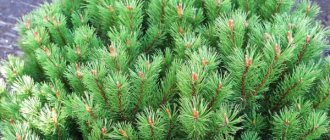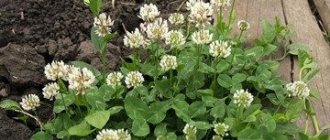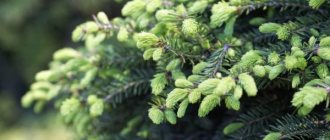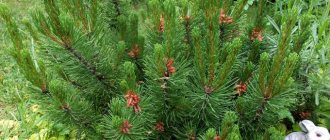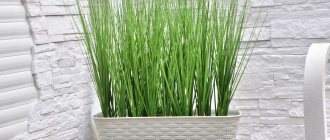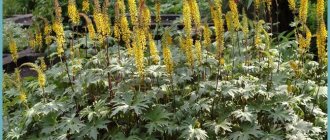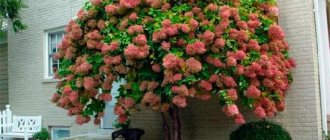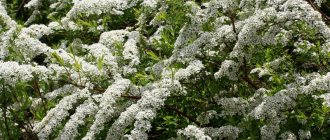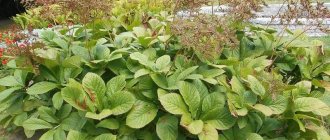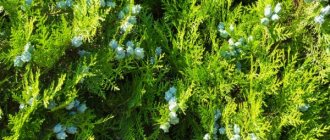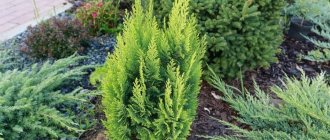Encyclopedia of Plants
Coniferous plants are always distinguished by their spectacular appearance and pleasant smell. There are many types and varieties of evergreen conifers, but microbiota is the original conifer. The unusual shape of the bush allows gardeners to intricately decorate their garden. This article will describe cross-pair microbiota, its features and cultivation rules.
- 1 Description of ephedra microbiota
- 2 Rules for growing and caring for microbiota 2.1 Reproduction and planting
Description of plant microbiota
The coniferous plant has only one name, no popular nicknames. This happened because the microbiota was completely unknown for a long time. At one time it was confused with false-cossack juniper, but later it became clear that this is a completely different plant.
In Russia, the microbiota grows in one form; it does not have any related plants. Despite its mention as an endangered species, microbiota is grown as an ornamental plant in many regions.
The cross-paired microbiota belongs to the cypress family; externally, the needles are similar to thuja. In the warm season it is green in color; in autumn and winter it turns brown-red.
The plant belongs to dioecious creeping shrubs, its height is no more than 0.5 meters, the diameter of the conifer can reach 2 meters. The branches are long, they grow slightly upward from the center, and then begin to press toward the ground. So the bush has a shell-shaped crown.
The branches themselves are flat and thin. The needles resemble very small green scales, their length is 2 mm, with a slightly pointed tip. The arrangement of the plates is dense in relation to each other.
Diseases and pests
Delosperma is quite resistant to pests and diseases. However, if liquid stagnates in the soil, for example, due to frequent watering or too dense soil, then the flower may rot.
The most common pests that settle on the bush are:
- Mealybug. The bushes are sprayed with an insecticide solution, the main active substance of which is cypermethrin.
- Aphids. If there are few pests, then dissolve half a bar of laundry soap in 5 liters of hot water. When the mixture has cooled, the bushes are treated with it.
- Spider mite. Using a cotton swab moistened with soapy water, remove as many pests from the plant as you can. Then it is sprayed with a solution of a chemical or biological acaricide.
Varieties
Despite the fact that the cross-paired microbiota is the only representative of its genus, recently separate varieties of this plant have begun to be developed:
- Northern Pride - this variety can cover a fairly large area of land on its own;
- Carnival - the crown of the bush is covered with frequent, light patches of golden color;
- Jacobsen is a dense shrub that grows taller than other varieties. The branches are slightly twisted, the coniferous scales are pointed;
- Goldspot – the branches of this microbiota are spotted, yellow areas acquire a golden hue in the fall;
- Celtic Pride is suitable for use in landscape design if you need to create a compact composition in a small area.
Cross-paired microbiota in landscape design
Microbiota in landscape design in the photo
Low growth and ground cover nature allow the use of microbiota in the foreground of compositions and at the foot of taller shrubs. It is very interesting as part of groups, the design of which is based on the principle of contrasting combinations of shape and color of the crowns. The plot can include from three to dozens of participants. In such landscape design compositions, the cross-paired microbiota has excellent compatibility with thujas, junipers, cypress trees, and low spruce trees.
Microbiota in landscape design in the photo
Stones and rocks are what the microbiota has a natural predisposition to. Even such a laconic plot as the microbiota at the foot of a large boulder looks complete and stylish, as if a fragment snatched from a natural landscape.
Microbiota in landscape design in the photo
The shrub is suitable for any type of rocky garden: flat rockery, mountain slope, alpine hill, architectural rockery. The main thing is that they match the size.
The plant looks interesting even in combination with concrete: in windows among paving slabs, on retaining walls. Planted along a path, it can hang gracefully over a sidewalk curb.
Look at the photo of cross-paired microbiota in landscape design - the dark green color of its needles looks especially beautiful in compositions with white-trunked birches:
Microbiota in design
Microbiota in design
This groundcover is also suitable for groups with tall species.
- Author: admin
Rate this article:
- 5
- 4
- 3
- 2
- 1
(7 votes, average: 3.9 out of 5)
Share with your friends!
Necessary conditions for good microbita growth
The plant belongs to rocks that are unpretentious to growing conditions in open ground. To ensure good growth, microbiota is planted in lighted areas with moist soil. The bush adapts normally to shaded areas. It winters under snow at 40 degrees below zero and tolerates strong winds.
The illumination of the area should not be accompanied by direct sunlight for a long time. Regardless of the planting location, you need to monitor the level of soil moisture and its looseness.
Loamy or sandy loam soil is well suited for cross-pair microbiota, especially with the addition of crushed stone in the form of drainage. Stagnant moisture at the roots has a bad effect on the plant. During the scorching sun, you need to irrigate the crown of the microbiota.
Important! A mulching layer around the tree trunk allows you to maintain soil moisture longer, especially in hot weather. In addition, it protects the soil from crust formation and excessive weed growth.
The microbiota looks beautiful against the background of rhododendrons, junipers, birches and rowan trees. Landscape designers often work with these combinations.
What other plants are good to combine microbiota in the garden with? Diseases and pests of shrubs
Microbiota looks great among stones, so it can be safely planted in rockeries in combination with dominant tall and dwarf spherical conifers. Deciduous trees, for example, barberry and bladderwort, are also suitable as neighbors.
The microbiota is good both in a single planting on the lawn and in a group planting as a border. In the same compositions of rockeries, beautifully flowering shrubs, for example, rhododendrons, Japanese quince, etc., will be even brighter against its background.
The plant is very rarely affected by diseases. Pests also “dislike” microbiota.
Cross-paired microbiota, thanks to its grace, can transform any area. It will cause little trouble, but you can admire its greenery for many years in a row.
Growing and Reproduction
Reproduction methods:
- by seeds , but this is a labor-intensive process. Extracting seeds from a plant cone is not as easy as it might seem. Storing planting material reduces its germination rate, so it is better to plant freshly harvested seeds. Stratification is important for most plant seeds and should be kept cold for a couple of months or planted in late fall to overwinter. Seeds in open ground under mulch will undergo natural stratification. Important! When growing seedlings from seeds at home, it gives a good level of survival rate after planting in open areas.
- Cuttings - This is the optimal way to propagate microbiota. Cuttings from a young bush show good results. It is better to make preparations in the summer. You need to trim strong shoots, but not those that are in the active growth phase. The length of the segment needs to be at least 15 cm. Rooting occurs in greenhouses or greenhouses, and planting should be strictly on the lower side. If you plant the branches at the beginning of summer, by the middle they will already begin to take root. In winter, not all cuttings will be able to survive, even if the weakest ones are protected from frost.
Important! If it is necessary to replant a young bush, its roots need to be trimmed a little, so the microbiota will take root faster.
- Stem layering is not used as often for propagation. After the shoot takes root, the separation of the sprouts from the mother bush occurs gradually.
Planting pattern:
- A hole is dug 0.4 meters deep and wide. Large sizes are not needed due to the compact microbiota roots.
- Crushed stone or gravel is poured into the bottom of the hole for drainage.
- The soil is made by mixing earth, sand and peat in equal parts. You can add some compost to this mixture.
- Place the microbiota in the hole and cover it with prepared soil, then water it and lay out a layer of mulch.
Important! There is no need to propagate the microbiota by dividing the bush; it is difficult for the roots to take root in a new place.
The distance between bushes depends on the purpose of planting. Basically, a gap of 1 meter is maintained, for a fence - 0.5 meters.
Microbiota genus and history of discovery
The term “microbiota” refers to a specific genus of evergreen coniferous shrubs belonging to the Cypress family. The genus consists of only one species, the so-called decussate microbiota ( microbiota
decussata
).
In its natural environment, this plant is a typical representative of the flora of the Russian Far East. Here the plant is found en masse in a fairly limited area occupying the southern and western slopes of the Sikhote-Alin. That is why this species is listed in the Red Book and is considered a rare flora, gradually limiting its numbers.
For official science, this plant was discovered relatively recently. It was first described by the famous Russian botanist Ivan Shishkin in 1921 during one of his expeditions along the Livadia mountain range. The microbiota was discovered on the top of Mount Hualaza, which today is called Krinichnaya. However, the scientist initially mistook this plant for one of the varieties of juniper.
Did you know? The so-called clonal colony “Pando” is considered to be the oldest living organism on the planet. This is a grove of aspen poplar with an area of 43 hectares, which is a single organism about 80 thousand years old.
In 1923, thanks to Academician Vladimir Komarov, the shrub was identified as a separate group. Studying herbarium specimens, Komarov concluded that this was a previously unstudied plant, which was very similar to the oriental planobranch, widely found in southern China. It is often referred to as “biota,” so the new shrub, like a kind of miniature copy of the flat-branched plant, was called “microbiota” by the scientist.
For many decades, the microbiota was unknown in the scientific world; the isolation of the USSR from other countries did not allow scientists to present their discovery abroad. The first foreign articles about this species appeared only in the 90s of the 20th century, which is considered the beginning of the cultivation of this species in the artificial landscape zone.
Video: History of discovery and description of cross-paired microbiota
How to care for your microbiota
water the bush regularly, but allow time for the soil surface to dry out. With the onset of warm weather, the microbiota is watered a couple of times a week, spending half a bucket of water per plant. In the absence of intense heat in the summer, the shrub is watered by sprinkling, and in the heat, crown spraying is added to the watering. For a year or two after planting, watering the microbiota should be done 3-4 times a week.
Fertilizers are used 3 years after planting, often organic matter in the form of mullein solution or compost. You can use complex fertilizers, especially those containing magnesium. It is involved in the process of photosynthesis.
Important! The complex of fertilizers for microbiota should not contain nitrogen. It can cause plant death in winter frost and contribute to the development of chlorosis.
loosen the soil regularly, but not after every watering, but as necessary. The roots of the microbiota need access to oxygen. Loosening is carried out carefully so as not to damage the root system. Weeds have a bad effect on the microbiota; they take away nutrition that is important for the plant. Weeds can cause diseases and pests.
Weeding is a mandatory activity along with loosening.
Trimming is carried out as necessary if there are dry and damaged branches. Pruning can be done in the spring, cutting off no more than a third of the bush evenly around its entire circumference.
In different styles
Molded plants can be used in gardens of almost any artistic style and direction, from regular ones, where they act as the most important form-building elements, to naturgardens, in which sheared conifers are used in the design of a private home space or in protective fences. In areas designed in a cottage style, green walls of garden rooms are built using molded conifers, and in eastern gardens they take pride of place as nivaki.
Labyrinths and nodal parterres require painstaking work
In our gardens you can increasingly see low bosquets and borders made of trimmed thujas, various topiary forms as part of coniferous groups and mixed compositions. The beauty and originality of trimmed conifers and their high decorative potential more than compensate for the hassle of caring for them.
_________________________________________________________
Caring for conifers in spring
With the arrival of spring and the beginning of the snow melting, it is time to carefully care for the garden. We have prepared several articles with recommendations that, if followed, will save you time and ensure the healthy growth of your trees and shrubs.
How to propagate a plant yourself
Reproduction of microbiota, if desired, is easy to do yourself. This is done using the following methods:
Since cones rarely appear on the plant and it is difficult to extract seeds from them, amateurs often use the second propagation method.
To grow microbiota from green cuttings, perform the following work:
In mid-summer, young but already lignified shoots with a heel are cut.
Advice. It is better to prepare cuttings for propagation in cloudy weather. This will protect both the cuttings themselves and the cuttings on the mother plant from damage from sunlight.
- The cut branches are freed from needles and bark to a height of 3-4 cm.
- The bottom of the planting container is covered with drainage material. Loose and nutritious soil is poured on top. A 1:1 mixture of sand and peat is suitable. Provide abundant watering.
- According to the number of cuttings, round holes of small diameter are made in the soil at an angle of 60°.
- A cutting is placed in each hole to the depth of the cut bark and squeezed.
- A greenhouse is built above the box.
Caring for cuttings includes watering and daily ventilation. Fertilizer is not needed during germination. Roots appear after 2.5-3 months. Until next summer, the plants are grown indoors.
Selecting a site for microbiota
Microbiota is a very strong plant, its crown can easily support the weight of a person, and in natural conditions it does not suffer even from the invasion of large animals. Thanks to its flexible branches, it does not break due to heavy snow. Ephedra tolerates a lack of light, preferring shady areas, and is able to grow on any moderately moist substrate. Planting cross-paired microbiota is permissible in calcareous soil. But the shrub develops best on fertile sandy or loamy soil.
With an excess of sunlight, the bush develops more slowly. Excess moisture also has a detrimental effect on the plant, because in nature it grows on dry rocky soils. The cross-paired microbiota tolerates cold and dry periods well, but does not tolerate waterlogging of the soil. One of the features of the shrub is the absence of a dense root system, which allows replanting at any time. Ephedra is well formed by pruning, it is resistant to most diseases and pests.
